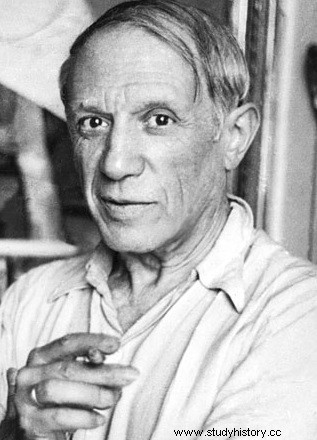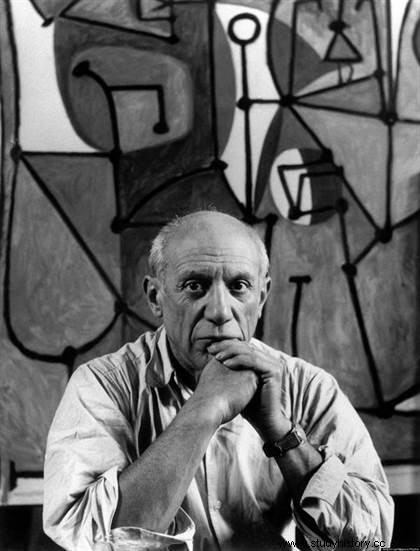 Spanish painter, draftsman and sculptor, Pablo Picasso is generally presented as one of the greatest artists of the XX
th
century. A ladies' man whose companions would deeply inspire his work, he was, along with Georges Braque, the founder of cubism and one of the pillars of modern art. Author of a rich work of more than 20,000 pieces, Pablo Picasso tries, from the 1950s, all the supports (lithography, engraving on linoleum, ceramics, sculpture, poster and painting) which approach as many themes as of techniques, revealing an exceptional creative freedom. The Ladies of Avignon , which marks the beginning of modern art, and Guernica , which refers to the Spanish Civil War, are among his most famous paintings.
Spanish painter, draftsman and sculptor, Pablo Picasso is generally presented as one of the greatest artists of the XX
th
century. A ladies' man whose companions would deeply inspire his work, he was, along with Georges Braque, the founder of cubism and one of the pillars of modern art. Author of a rich work of more than 20,000 pieces, Pablo Picasso tries, from the 1950s, all the supports (lithography, engraving on linoleum, ceramics, sculpture, poster and painting) which approach as many themes as of techniques, revealing an exceptional creative freedom. The Ladies of Avignon , which marks the beginning of modern art, and Guernica , which refers to the Spanish Civil War, are among his most famous paintings.
Biography of Pablo Picasso
Born on October 25, 1881 in Málaga (Andalusia), Pablo Ruiz began drawing at a very young age with his father, a drawing teacher. From 1895, he studied at the School of Fine Arts in Barcelona, La Lonja, before continuing at the Royal Academy of San Fernando in Madrid. Returning from 1899 to Barcelona, he worked in particular by making illustrations for magazines and newspapers and frequented the Cabaret els quatre gats. In 1901, he adopted his mother's name as his signature:"Picasso". From now on, he will sign his works in this way.
From 1904, he settled permanently in France after three stays in previous years. He first moved with his first wife Fernande Olivier to the famous Montmartre workshop, the Bateau-Lavoir. He meets in the capital among many others:Max Jacob, Guillaume Apollinaire, Henri Matisse or Braque with whom he invents Cubism. From 1910, he regularly stayed in Provence with Derain and Braque, returning however to the capital, especially during the First World War to collaborate with the Russian ballets. Although the two men do not know each other, Picasso and Toulouse Lautrec paint the same Paris of the 1900s and share a passion for the effervescence of the lively places of the capital, for caricatural portraits or for the world of the circus.
In 1925, he participated in the first Surrealist exhibition at the Galerie Pierre in Paris. He does not, however, adhere to the movement. He became the companion of Marie-Thérèse Walter between 1927 and 1935, with whom he had a daughter:Maya Widmaier-Picasso. In 1936, he joined the Spanish Republicans against Franco. During the Second World War, he returned to work in Paris despite his qualification as a "degenerate artist" by the Nazi regime. It was only after the Liberation that he joined the Communist Party and returned to live in the south of France. He maintains relations with a good number of artists, including Jean Cocteau with whom he exchanges a considerable number of letters. From 1958, he made Château de Vauvenargues one of his private residences. He died on April 8, 1973 near Mougins.
From the Blue and Rose periods to Cézanne
Pablo Ruiz Picasso's work begins with different periods symbolized by colors. From 1901 to 1904 corresponds to the Blue period. He then uses cold tones with a dominant blue in his painting. Picasso presents bare backgrounds with characters suffering from the harshness of life (The Poor at the Seaside , 1903) with a sinister and dark side, inspired by the painter El Greco (The girl with the crow , 1904). After a phase of transition, Picasso entered his Rose period (1905-1906), which was milder even if he retained the same themes, notably illustrating the artists and acrobats of the Médrano circus, which he frequented regularly (Acrobate and young harlequin , 1905).
 From 1906 to 1908, he approached the work of Cézanne while being interested in art primitive Iberian and African art. This period also corresponds to his meeting with the Steins (brother and sister), American Jews living in Paris and buying works with real commercial potential:Renoir, Cézanne, Manet, etc. The sister, Gertrude Stein, took a strong interest in Henri Matisse and Picasso introducing the two artists to each other. She commissioned her portrait from Picasso. With great sobriety and austerity, it is more of a statuary representation than a true portrait.
From 1906 to 1908, he approached the work of Cézanne while being interested in art primitive Iberian and African art. This period also corresponds to his meeting with the Steins (brother and sister), American Jews living in Paris and buying works with real commercial potential:Renoir, Cézanne, Manet, etc. The sister, Gertrude Stein, took a strong interest in Henri Matisse and Picasso introducing the two artists to each other. She commissioned her portrait from Picasso. With great sobriety and austerity, it is more of a statuary representation than a true portrait.
The following year, he produced a work announcing a revolution in the history of 20th century art, Les Demoiselles d'Avignon (1907). This "ex-voto painting" refers both to Cézanne and to African and primitive art, it also marks the beginning of a new movement, cubism.
Pablo Picasso and the cubist movement
Picasso appears as the main representative of Cubism with Georges Braque. This movement poses a controversy by developing a new way of painting, by breaking down the forms and by multiplying the points of view which appear simultaneously on the same work. Indeed, if artists like Albert Gleizes and Jean Metzinger will develop a real theory of cubism, Picasso and Braque remain attached to technical novelty more than to theory. Following on from Cézanne's pre-Cubism, the years 1908 to 1912 correspond to "Analytical Cubism" of which Picasso will say "it is simply an art which is concerned with form". He seeks to break the traditional perspective (Woman seated in an armchair, 1910 ).
The artist then entered the period known as "Synthetic Cubism" where he reintroduced color into his work while purifying forms more and more. It was also during this period that he made his first collages in order to abolish the difference between painting and sculpture.
A new turning point
The end of World War I and the 1920s also marked the end of Cubism. In people's minds, this current is attached to modernity, this same modernity, a factor of war and death. From 1925, Picasso shows a radical turn by approaching Surrealism (Bather playing with a ball , 1932). In 1935, he exhibited a whole series of papiers collés at the Galerie Pierre in Paris. On a trip to the south of France with Dora Maar, Picasso produced his painting Night Fishing in Antibes. During the Second World War, he will frequent in Paris another artist-painter, Françoise Gilot.
Subsequently, his work announces the rise of tensions, cruelty (series of Corridas and Minotaurs ) and especially of the war in Europe. On this subject, his most emblematic work remains Guernica (1937) which he painted for the Spanish Pavilion at the Universal Exhibition in Paris. A mural to be inspired by the Spanish Civil War, this work symbolizes above all the horror and barbarity of conflict.
 After the Second World War and joining the Communist Party, Picasso painted works against the absurdity of war and for peace (Joy of living , 1946; War and Peace , 1952). He affirms:“Painting is not made to decorate apartments. It is an instrument of offensive warfare against the enemy.” Among other things, he designed a dove for the World Peace Congress in 1949.
After the Second World War and joining the Communist Party, Picasso painted works against the absurdity of war and for peace (Joy of living , 1946; War and Peace , 1952). He affirms:“Painting is not made to decorate apartments. It is an instrument of offensive warfare against the enemy.” Among other things, he designed a dove for the World Peace Congress in 1949.
Constant inventor of forms, inexhaustible worker, he will however continue until the end of his career his questioning on the different styles of painting, revisiting famous paintings (Les Meninas , after Vélasquez, 1957). Feeling time inexorably flowing in his last years, he produced with unquenchable passion and fervor a powerfully erotic series on couples. For Pablo Picasso, “It is in the work of a lifetime that true seduction resides”.
Bibliography
- Picasso by Gilles Plazy. Biography Folio, 2006.
- Pablo Picasso, biography of Pierre Daix. Tallandier, 2007.
- About the art of Pablo Picasso. Gallimard, 1998.
To go further
- Picasso Museum in Paris
- Metropolitan Museum of New York
- Prado Museum
